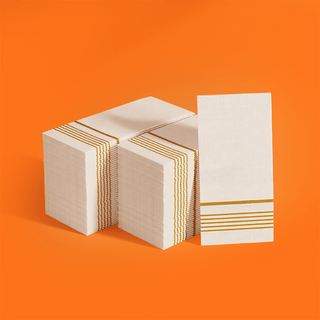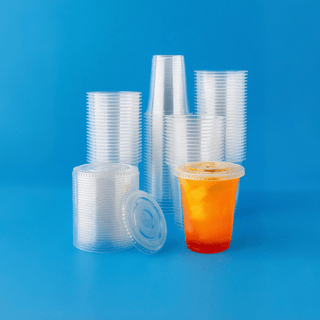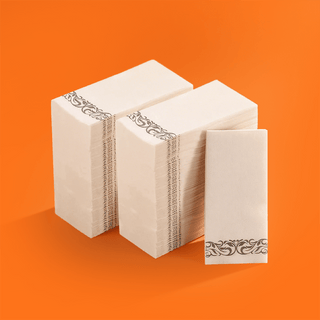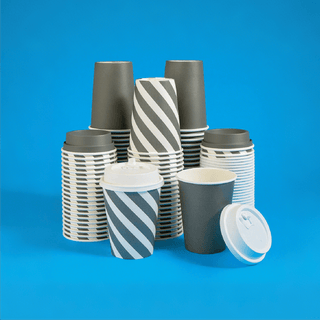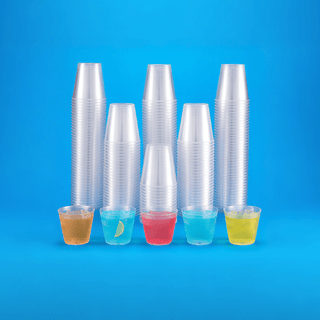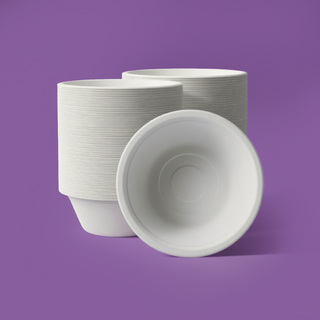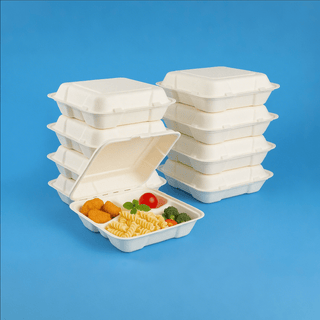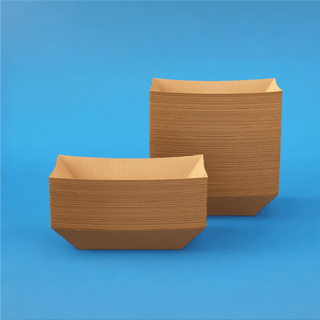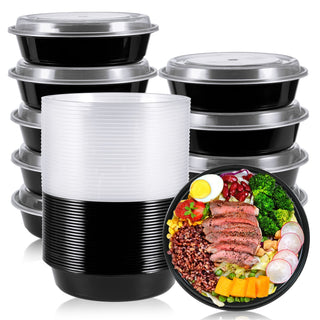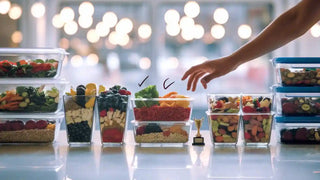
Which Meal Prep Container Wins
You want the best meal prep container for your needs. Glass meal prep containers win for most users because they balance safety, durability, and convenience. You get a container that handles hot and cold meals, keeps food fresh, and resists stains. Glass containers work well for meal prep at home or for business. If you need non plastic meal prep containers for large orders, glass options offer strong value. You can rely on these containers for repeated meal prep and storage.
Key Takeaways
Glass meal prep containers offer safety, easy cleaning, and keep food fresh, making them ideal for home use and presentation.
Stainless steel containers provide unmatched durability and temperature retention, perfect for bulk delivery and travel.
Silicone containers are lightweight, flexible, and space-saving, great for on-the-go meals but may leak if lids are not secure.
Choose containers based on your needs: glass for freshness and microwave use, stainless steel for durability and heat, silicone for portability and storage.
Investing in quality containers saves money long-term by reducing replacements and supporting eco-friendly practices.
Comparison Table
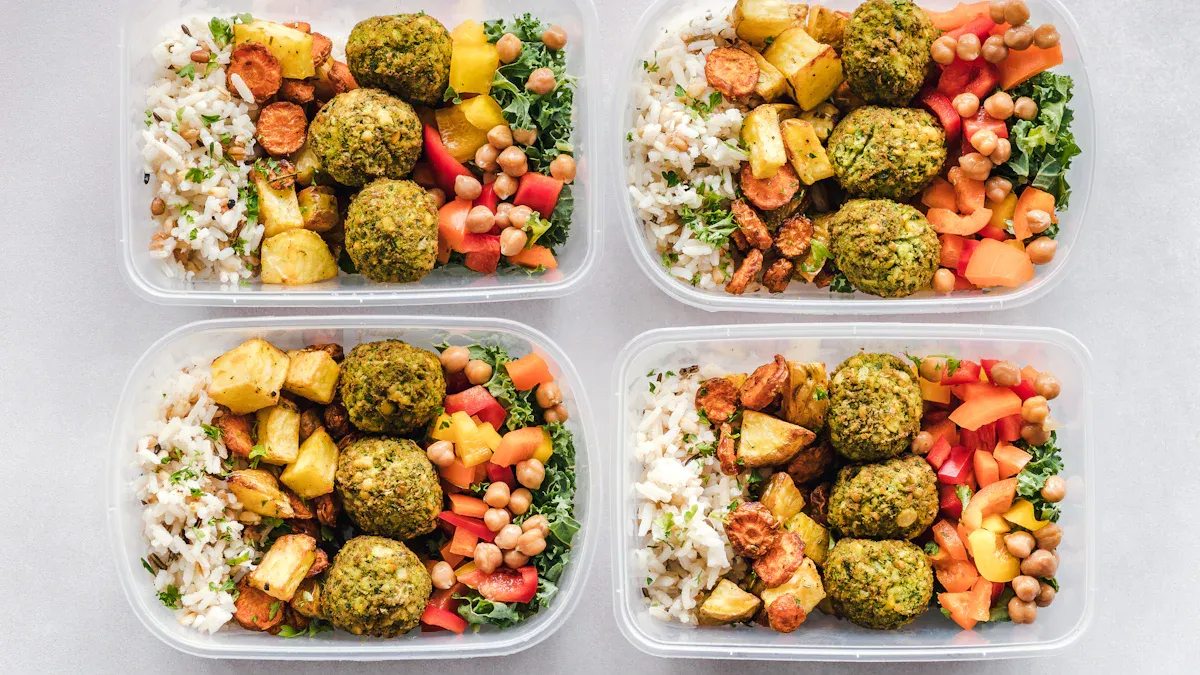
When you choose meal prep containers for your business, you want to compare the main meal prep container materials side by side. The table below gives you a quick overview of glass, stainless steel, and silicone containers. You can see how each container material performs in safety, durability, convenience, and cost. This helps you pick the right meal prep containers for your needs.
Attribute |
Glass Containers |
Stainless Steel Containers |
Silicone Containers |
|---|---|---|---|
Safety |
Non-toxic, no chemical leaching, microwave safe |
Non-toxic, not microwave safe |
Non-toxic, flexible, lightweight |
Durability |
Durable but breakable, resists stains/odors |
Unmatched durability, resists dents and corrosion |
Flexible but less rigid, lightweight |
Convenience |
Microwave and dishwasher safe, transparent |
Lightweight, excellent temperature retention |
Flexible, great for on-the-go use |
Cost |
More expensive upfront, long-lasting |
More expensive upfront, long-lasting |
Generally affordable, cost details vary |
Glass
Glass containers give you a safe and reliable meal prep solution. You can use glass containers for hot and cold meals. Glass containers do not leach chemicals, so you keep food quality high. You can see your meal through the transparent glass, which helps with inventory and presentation. Glass containers work well in microwaves and dishwashers, saving you time. You get long-lasting value, but glass containers can break if dropped. Many businesses choose glass containers for meal prep because they keep food fresh and resist stains and odors.
Stainless Steel
Stainless steel containers offer unmatched durability for meal prep. You can use stainless steel containers for both hot and cold meals. Stainless steel containers resist dents and corrosion, so you get a long-lasting meal prep container. You cannot use stainless steel containers in microwaves, but they keep food at the right temperature for longer periods. Stainless steel containers are lightweight and easy to transport. Many merchants and event planners prefer stainless steel containers for large orders because they handle frequent use and travel well.
Silicone
Silicone containers provide flexibility and portability for meal prep. You can fold or stack silicone containers, saving space in storage. Silicone containers are lightweight and non-toxic, making them easy to carry for on-the-go meal prep. You can use silicone containers for baking, freezing, and microwaving meals. Silicone containers are generally affordable, but they are less rigid than glass or stainless steel containers. Many businesses use silicone containers for events or travel where convenience matters most.
Tip: When you select meal prep containers, match the container material to your business needs. Glass containers work best for presentation and freshness. Stainless steel containers excel in durability and temperature retention. Silicone containers shine in portability and flexibility.
Safety
Glass Meal Prep Containers
When you choose glass meal prep containers, you select a material that is non-reactive and inert. Glass does not leach chemicals or metals into food, even when you store acidic meals. You can use glass containers for hot or cold food without worrying about contamination. Glass meal prep containers keep food quality high and preserve the original taste and aroma. You can rely on glass for microwave, dishwasher, and freezer use. Glass containers do not absorb odors or stains, so you maintain food quality with every meal prep cycle. Many businesses prefer glass containers for their reliability and safety in large-scale meal prep operations.
Tip: Glass meal prep containers work well for storing salads, pasta, and sauces. You can use them for both short-term and long-term food storage.
Stainless Steel
Stainless steel meal prep containers offer strong safety for food storage. Stainless steel is non-toxic and resists corrosion. You can use stainless steel containers for most foods, but you should avoid storing acidic meals for long periods. Acidic food may cause minimal metal leaching, which can affect food quality. Stainless steel containers do not absorb odors or flavors, so you keep food fresh. You cannot use stainless steel containers in microwaves, but you can use them in ovens or on stovetops without lids. Many merchants and event planners choose stainless steel meal prep containers for their durability and safety in high-volume meal prep.
Stainless steel containers excel in temperature retention.
You can use them for hot and cold food.
They provide a practical solution for transporting meals.
Silicone
Silicone meal prep containers provide a safe and flexible option for food storage. Silicone is a non-toxic, BPA-free polymer that does not leach harmful chemicals into food. You can use silicone containers for baking, freezing, and microwaving meals. Silicone meal prep containers create airtight seals, which help maintain food quality and freshness. Regulatory agencies like the FDA and LFGB test silicone for safety, focusing on migration limits and toxicity. You can trust silicone containers for storing a wide range of foods, including snacks, fruits, and baked goods.
Material |
Non-Toxic |
Chemical Leaching |
Microwave Safe |
Suitability for Foods |
|---|---|---|---|---|
Glass |
Yes |
None |
Yes |
All foods, including acidic |
Stainless Steel |
Yes |
Minimal (acidic) |
No |
Most foods, avoid acidic |
Silicone |
Yes |
None |
Yes |
All foods |
You can see that glass, stainless steel, and silicone meal prep containers all provide safe options for food storage. Each container material offers unique advantages for different meal prep scenarios. You can select the best container for your business needs by considering food type, application, and safety standards.
Durability
Impact Resistance
When you select meal prep containers for your business, you want products that can handle daily use. Impact resistance measures how well a container stands up to drops, bumps, and rough handling. Each material reacts differently to impact.
Material |
Impact Resistance Features |
|---|---|
Glass |
Prone to cracking or breaking if dropped. Abrupt temperature changes can cause damage. |
Stainless Steel |
Highly resistant to dents and drops. Maintains shape even with frequent handling. |
Silicone |
Flexible and bounces back from drops. Less likely to crack but can deform under pressure. |
Glass containers look professional and keep food visible, but they can break if you drop them. Stainless steel containers offer the most durable option for impact resistance. You can use them in busy kitchens or for catering events where containers move often. Silicone containers resist breaking, but they may lose shape if you stack heavy items on them.
Tip: For high-traffic environments, stainless steel containers give you peace of mind. You avoid frequent replacements and keep your supply chain running smoothly.
Longevity
You want containers that last through many uses. Longevity depends on how well a container resists wear, stains, and odors over time. Experts Javier and Rebeca Medina note that glass containers can scratch or crack, especially with sudden temperature changes. Stainless steel containers resist most damage, but long exposure to acidic foods may cause minor metal leaching. Silicone containers can degrade or develop odors if made with cheap fillers, so quality matters.
Glass containers stay clear and odor-free, but you must handle them with care.
Stainless steel containers remain durable and reusable for years, even with heavy use.
Silicone containers last if you choose high-quality products, but lower-grade options may not hold up.
When you invest in meal prep containers, you want durability and value. Stainless steel stands out for its long life and low risk of damage. Glass and silicone also offer strong performance if you match the container to your business needs.
Convenience
Portability
When you select meal prep containers for your business, portability matters. You want containers that make meal prep and transport easy. Glass containers feel heavy and bulky, especially in larger sizes. They do not stack well, and their lids can be flimsy. This makes glass less ideal for carrying meals to events or for delivery. Stainless steel containers stand out for portability. They are lightweight, sturdy, and compact. You can move meals from kitchen to client with less effort. Silicone containers offer ultra-lightweight and collapsible designs. You can fold them flat after meal prep, saving space. However, silicone containers often struggle with leak resistance. Their lids may not stay secure, so liquids can leak during transport.
Container Type |
Portability Aspects |
|---|---|
Glass |
Heavy, fragile, not stackable, better for home meal prep |
Stainless Steel |
Lightweight, sturdy, easy to carry, ideal for meal delivery |
Silicone |
Ultra-light, collapsible, but prone to leak issues |
Tip: For large orders or catering, stainless steel containers give you the best mix of portability and reliability.
Cleaning
You want meal prep containers that are easy to clean and maintain. Stainless steel containers are dishwasher safe, except for the lids. You can remove silicone seals and lid valves for thorough cleaning. Avoid bleach or abrasive scrubbers to keep containers looking new. Silicone containers also go in the dishwasher, but they may retain odors after repeated meal prep. Glass containers resist stains and odors, making them a top choice for meal prep businesses that value freshness. You can wash glass containers in the dishwasher, which saves time in busy kitchens.
Stainless steel: Dishwasher safe (except lids), removable seals for deep cleaning.
Silicone: Dishwasher safe, but may hold odors.
Glass: Dishwasher safe, resists stains and odors.
Microwave & Oven Use
Meal prep often requires reheating or baking. Glass containers work well in both the microwave and oven. You can prep, store, and reheat meals in the same container. Stainless steel containers do not go in the microwave, but you can use them in the oven without the lid. Silicone containers handle microwave use, but always check the product label for oven safety. Glass stands out for versatility in meal prep, storage, and reheating.
Note: Always check the manufacturer's guidelines for microwave and oven use to avoid damage.
Storage
Efficient storage helps you manage meal prep at scale. Silicone containers collapse flat, saving space in your kitchen or warehouse. You can store many containers in a small area. Glass and stainless steel containers do not nest as well. Glass containers take up more space and do not stack securely. Stainless steel containers offer some stackability, but not as much as silicone. For businesses with limited storage, silicone containers provide a clear advantage, but you must balance this with their leak resistance.
Silicone: Collapsible, space-saving, but less air tight and leak proof.
Glass: Bulky, not stackable, but air tight and leak proof.
Stainless steel: Stackable, sturdy, and air tight and leak proof.
Cost & Value
Initial Cost
When you compare meal prep containers, you notice that initial cost varies by material. Glass containers usually cost more upfront. You pay for the quality and the non-reactive nature of glass. Brands like Pyrex and Snapware lead the market for glass containers. These brands offer durable products that many businesses trust.
Stainless steel containers also have a higher initial price. You invest in strength and rust resistance. Rubbermaid and Tupperware are top choices for stainless steel containers. These brands have a strong reputation for reliability in commercial kitchens.
Silicone containers often cost less at the start. You find many options, but no single brand dominates the market. Silicone containers attract buyers with their flexibility and lower price point. You can buy them in bulk for events or travel needs.
Tip: If you want to control costs, compare bulk pricing from leading brands. This helps you manage your budget and meet your business goals.
Container Material |
Most Popular Brands (Based on Sales Data) |
Typical Initial Cost Level |
|---|---|---|
Glass |
Pyrex, Snapware |
High |
Stainless Steel |
Rubbermaid, Tupperware |
High |
Silicone |
No clear leader |
Moderate to Low |
Long-Term Value
You want containers that last and save money over time. Glass containers resist stains and odors. You can use them for years if you handle them with care. They keep food fresh and look professional for clients.
Stainless steel containers stand out for long-term value. You get unmatched durability. These containers handle frequent use and rough transport. You rarely need to replace them, which lowers your total cost.
Silicone containers offer value for specific uses. You can fold and store them easily. They work well for travel or events. However, lower-quality silicone may not last as long as glass or stainless steel.
Glass: High upfront cost, but strong long-term savings if handled carefully.
Stainless steel: Best for heavy use and long-term savings.
Silicone: Good for short-term or flexible needs, but may need more frequent replacement.
Note: Choose the container that matches your business needs. This helps you maximize value and reduce supply chain headaches.
Best Non Plastic Meal Prep Containers
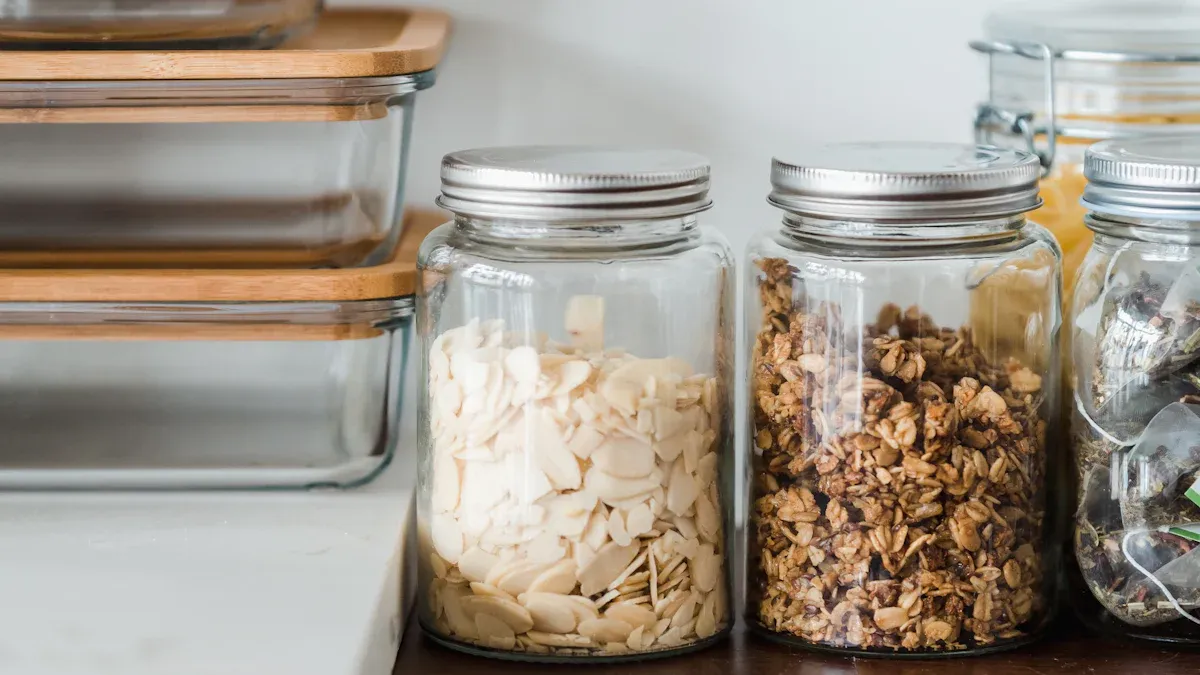
Choosing the right non plastic meal prep containers for your business helps you deliver fresh, safe, and appealing meals to clients. You want containers that match your application, whether you serve meals at home, deliver food on-the-go, cater for kids, or prioritize eco-friendly options. Below, you will find recommendations for the best meal prep containers in each scenario, based on expert reviews and practical features.
Best for Home Use
You need meal prep containers that keep food fresh, look professional, and stand up to daily use. Glass containers offer a reliable solution for home meal prep. You can use them for hot and cold meals, and they resist stains and odors. Many experts rate Bentgo Signature Leakproof Glass Containers as the top choice for home use. These containers feature leakproof silicone and glass lids, a microwave steam valve, and a size ideal for lunches. Caraway Glass Food Storage Set also stands out for its toxin-free design and long-lasting quality, though it comes at a higher price. Rubbermaid Brilliance Food Storage Set receives high marks for durability and leakproof lids, with nearly 95,000 perfect ratings. Ball Mason Jars work well for small portions and freezing, while Ello Duraglass Glass Food Storage Container offers heat protection and secure lids.
Container Name |
Key Features & Expert Highlights |
Expert Rating / Popularity Indicator |
|---|---|---|
Bentgo Signature Leakproof Glass Containers |
Leakproof silicone and glass lids, great size for lunches, microwave steam valve, favorite for packing lunches |
Highlighted as best-rated non-plastic container by experts |
Caraway Glass Food Storage Set |
Toxin-free, versatile, microwave/oven/freezer/dishwasher safe, includes storage organizer, long-lasting but pricey |
Recognized for quality and longevity despite higher price |
Rubbermaid Brilliance Food Storage Set |
Leakproof lids, microwave-safe vents, BPA-free, highly durable, nearly 95,000 perfect Amazon ratings |
Highly rated and praised for durability and design |
Ball Mason Jars |
Airtight, freezer safe, wide mouth for easy filling, good for small portions |
Recommended for smaller food storage and freezing |
Ello Duraglass Glass Food Storage Container |
Integrated silicone sleeve for heat protection, secure leakproof lid |
Longtime favorite for durability and ease of use |
You can rely on these glass meal prep containers for repeated use, easy cleaning, and attractive presentation. They help you maintain food quality and reduce supply chain headaches.
Best for On-the-Go
When you deliver meals or serve clients outside the kitchen, you need meal prep containers that travel well. Lightweight, leakproof, and stackable containers make meal prep and transport easier. Glass containers, especially borosilicate glass, excel in durability and temperature tolerance, but they feel heavier. Silicone containers offer ultra-lightweight and collapsible designs, saving space and making transport simple. Stasher Silicone Bags provide a reusable, structured silicone option with a flat bottom for liquids, making them a recommended alternative to plastic bags.
Key features for on-the-go meal prep containers include:
Leakproof airtight seals to prevent spills
Stain- and odor-resistant materials for freshness
Built-in microwave vents for easy reheating
Lightweight, durable construction for portability
Stackable designs for space-saving storage
Compartments or dividers for portion control
You can choose glass meal prep containers for durability and temperature versatility, or silicone containers for flexibility and portability. Both options help you deliver meals efficiently and keep food safe during transport.
Best for Kids
You want meal prep containers that protect children’s health and withstand frequent use. Safety certifications matter most. Containers for kids should be BPA-free, non-toxic, and free from harmful chemicals like phthalates and BPS. Glass and silicone containers offer durability and safety, making them preferred choices. Stainless steel containers made from high-quality 18/8 steel provide a safe, toxin-free environment for food. These containers feature secure snap-on lids and silicone straps to prevent spills. You can clean them easily in the dishwasher, supporting hygiene and safety.
Recommended features for kids’ meal prep containers:
Entirely plastic-free, toxin-free, and weld-free construction
BPA-free, BPS-free, PP-free, phthalate-free, and plastic-free
Secure lids and straps to prevent spills
Dishwasher-safe for easy cleaning
Freezer and microwave-safe options for convenience
Airtight seals to preserve food quality
You can select glass, silicone, or stainless steel meal prep containers for kids to ensure safety, durability, and ease of use.
Best for Eco-Friendly Choices
You may want meal prep containers that support eco-friendly practices. Reusable containers help reduce waste and offer long-term value. Glass containers are environmentally favorable because they are inert, non-toxic, and recyclable. Stainless steel containers are durable and rust-resistant, with recycling options that enhance sustainability. Silicone containers, such as Stasher Bags, provide a plastic-free, reusable alternative, though manufacturing impact details are limited.
Material |
Additional Notes |
|
|---|---|---|
Stainless Steel |
Production relies on coal derivatives, recycling possible |
Durable, rust-resistant, long-lasting; not microwave-safe. Efforts exist to develop coal-free steel. |
Glass |
Inert and recyclable, environmentally friendly |
Resistant to odors and stains; can be reheated; fragile and may come with plastic lids. |
Silicone |
Plastic-free and durable alternative |
Reusable and space-saving; alternative to single-use plastics. |
Reusable polypropylene containers can be more eco-friendly than single-use plastics if you reuse them enough times. Compostable containers made from plant fibers or bioplastics offer benefits but face higher costs and limited composting infrastructure. Many environmental advocates recommend reusable containers over compostable ones due to lifecycle impacts and practical limitations.
You can choose glass, stainless steel, or silicone non plastic meal prep containers to support eco-friendly goals and reduce supply chain costs. These containers offer durability, safety, and long-term value for your business.
Tip: Match your non plastic meal prep containers to your business needs. Glass containers work best for home and presentation. Silicone containers shine for travel and flexibility. Stainless steel containers excel in durability and safety for kids. Reusable containers help you manage costs and support eco-friendly practices.
You want the best meal prep containers for your business. Glass stands out as the overall winner because you get versatility, easy cleaning, and strong food safety. Stainless steel works well for hot meal prep and travel, keeping food warm for hours. Silicone gives you flexibility and handles extreme temperatures. Most buyers choose containers that keep food fresh, offer convenience, and help control costs. Pick the meal prep solution that matches your workflow and client needs.
FAQ
What is the best meal prep container for bulk meal delivery?
You should choose stainless steel containers for bulk meal delivery. They resist dents, stack easily, and keep food warm. You save time and reduce replacement costs because they last longer in high-volume operations.
Can you use glass meal prep containers for hot foods?
Yes, you can use glass containers for hot foods. Glass handles temperature changes well. You can reheat meals directly in the container. This saves time and keeps food presentation professional.
Are silicone meal prep containers leakproof?
Most silicone containers offer flexible seals, but not all are fully leakproof. You should test the lids before using them for liquids. For soups or sauces, select containers with locking lids for better security.
Which container type is easiest to clean in commercial kitchens?
Glass containers clean easily and resist stains. You can wash them in dishwashers without worry. Stainless steel also works well, but avoid harsh scrubbers. Silicone may hold odors after repeated use.
How do you choose the right size for meal prep containers?
You should match container size to your portion needs. For main courses, use larger containers. For sides or snacks, select smaller sizes. Standardizing sizes helps you streamline packing and inventory.


